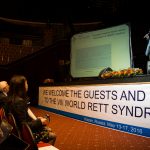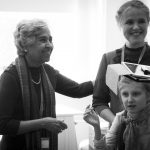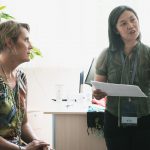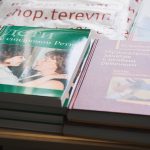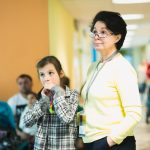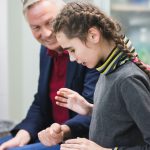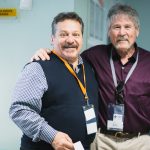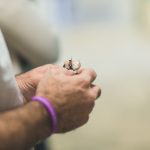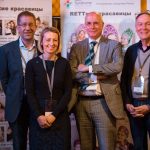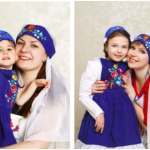The 8th World Congress on Rett syndrome took place in the millennium city of Kazan in the Tatarstan republic of the Russian Federation. There, international scientists and doctors met families and Rett girls for 5 days.
The congress program included a plenary session during the first days then parallel sessions the following days. Visits of children and adult rehabilitation centres, as well as a children’s hospice were planned. The families had the opportunity to meet the international medical doctors who offered consultations for their children.
During the plenary session, an overview of the situation in Russia was performed by I.Y Iourov: 391 girls and 3 boys were diagnosed with Rett Syndrome (RTT). Most of the girls showed mutations in the Mecp2 gene. But amongst the 29% of RTT girls without a mutation in Mecp2, a vast majority were found to have micro-deletions in the Xq28 chromosome marker located at the tip of the X chromosome. The mecp2 gene is located in this region. I.Y Iourov was particularly interested in analysing the “MECP2 interactome”, the pathway where the protein is involved and see if we can understand whether one or more particular targets interacting with MECP2 protein can be responsible of symptoms. This approach relied on Systems Biology methods and computational analysis based on data aggregated from the literature.
A video lecture from A. Percy gave an overview the natural history of RTT since 2003.
- Leonard gave a clear explanation on how the role of databases and population-based registries can be of great help in understanding the disease. Examples of studies were given such as the symptoms’ severity of girls and women with a C-terminal deletion of mecp2 compared to those who have point mutations in this gene, or breathing patterns and other autonomic functions and their relationship with age or mutation type.
H.Y. Zoghbi, through a video lecture, revisited the recent therapeutic possibilities. Mutations in the mecp2 gene lead to an altered function of the MECP2 protein. One idea is to try to boost the expression of the protein to counter-balance the loss of efficacy of the mutated protein. This would lead to try to find other proteins that up-regulate the expression of MECP2. Another approach is to work on different types of neurons in different region of the brain because some might be more important in the control of epilepsy for instance. The third and probably most novel approach is the electric deep-brain stimulation of neuron bundles in mice hippocampus. A new study showed that, in these models, a benefit in the memory and behaviour was clearly observed. The next studies will focus on the frequency and length of stimulations needed to keep a beneficial effect. Moreover the study would need to check if the beneficial effect could be durable with time.
- Naidu’s talk focused on the hypothesis that glutamate toxicity could be the causal effect of seizures in Rett syndrome. Indeed, RTT patients are lacking glutamate receptor at the post-synaptic level. The un-captured glutamate molecules are then binding to another type of receptors at the extra-synaptic level, causing toxic effects.
V.Y Voinova came back to the RTT cohort in Russian with more precise figures. 391 RTT girls or woman were diagnosed from 22 months to 32 years of age. All are sporadic events; only one mother who had gonads mosaicity had 2 RTT girls from 2 different husbands. The most common mutations are R255X and R168X, which correlate with statistics worldwide. 7 cdkl5 cases were measured (5 point mutations and 2 deletions in the cdkl5 gene). Foxg1 sequencing was not available at the Moscow genetic centre hence no data were available. Death toll was also mentioned and as far as parents have given feedback to doctors, 13 deaths only have been reported with diagnosed causes (5 chest infections, 2 QT elongations and 6 severe epilepsies).
- Budden explained that gallbladder pain occurs more frequently in individuals with RTT compared with general population, hence gallbladder should be considered if there is abdominal pain. An important message was to avoid giving fibres to Rett individuals without a lot of fluid. It was also observed that children, who were very active when there were younger, are likely to become depressed when they become more restricted in movements when they get older. S. Budden, in another talk, reminded that Rett children with early hypotonia and who did not acquire sitting by 2 years seldom acquire walking. Rigidity begins often around 5-9 years; the first sign is the tightness of the heel cords. This could be related to a decreasing dopamine level in the brain: interfering in this dopamine level with drugs currently used in Parkinson’s disease might lead to improvements. One interesting observation was the use of arm stretchers (elbow splints) to improve standing position, walking ability and increase focus on the action of walking.
A presentation of a new project “development of clinical guidelines for the management of communication in Rett Syndrome” was given by L.M.G Curfs. The project started during the European Rett Syndrome Conference in Maastricht in 2013. The project will last 2 years and is conducted by Rett Expertise Centre Netherlands (Gill Townend and Leopold Curfs) with a core group: Helena Wandin (Sweden), Theresa Bastolotta (USA), Anna Urbanowicz (Australia), Sally-Ann Garrett (UK & Ireland).
A follow-up on the Maastricht Experience was given by E.E.J Smeets. It was mentioned that there was a need to define the immaturity of the brainstem of each individual child and identify the cardiorespiratory phenotype (forceful, feeble or apneutic breather). On this base an individualized management strategy for each cardiorespiratory phenotype can be made. Most important, the distinction between seizures and non-seizures events. Some events as breath holding, hyperventilation, vacant spells, screaming laughter, stiffening, tremulousness, falling forward, pupil dilation, gazing and involuntary movements can be seen as seizures and they are not. Even if EEG shows epileptic abnormalities it doesn’t necessarily mean that there are seizures, an EEG video monitoring can be helpful to differentiate seizures from non-seizure events.
The results of M. Lotan’s research suggest that fear of movement in individuals with RTT stems from misinterpretation of messages from the proprioceptive system. This leads to obscure body scheme causing apraxia. It is difficult to move when you have fear to move, when you have an overactive sympathetic system, an abnormal muscle tone, not enough training and an external point of support. Exercises with balance board, stability disc exercises on unstable surfaces, hippo-therapy can improve the proprioceptive capabilities. A good control of trunk and pelvic movements is necessary for well-controlled movements, required to perform activities of daily living. Children with RTT have reduced ability to modulate muscle coupling and movement patterns of the pelvis can be improved by training. As a conclusion, a good training program should be implemented from young age to prevent fear of movement and fixations from developing.
A follow up of these observations was done in another talk where M. Lotan reminded that walking is important to improve the cardio-vascular system, to prevent scoliosis, osteoporosis, constipation and motor deterioration. Losing and regaining independent walking is a common phenomenon in individuals with RTT with independent walking. The reasons for the cessation of independent walking were always knew, it is important to diagnose the reason and initiate an intensive walking program if needed. Most of the time they regain walking spontaneously. You can regain walking at any age.
There is no pathological element detected in individuals with RTT (muscle/skeletal/neurological), which might impose lost of ambulation. Again, the mention of changing the 4 stages of the disease back to only 3 stages was pointed, as suggested by Dr Alison Kerr: pre-regression, regression and post-regression.
- Nguyen expressed his desire to remind families that parents should take care of themselves in the first place. A Rett child is completely dependent of his parent for his feeding, drinking, care and partially for his communication. For these reasons it is important to take care of our own needs as a good network, psychological help and most important happiness. Only then we will be able to be a good carer for our child.
A focus on Rehabilitations centres and methods was performed. S. Budden mentioned that it was absolutely essential to have a trans-disciplinary team approach in relation to the patient: communication with parents, physicians, therapists and educators is crucial. The expression of MECP2 mutations is reflected at different ages with changing behaviour and clinical affects on different organs but sparing the eyes. Receptive language is better preserved than motor areas. Treatment should not be based on their mutation, each child is different, there are many examples of children that are doing better then what the expectations were with the genotype Rett syndrome is not a degenerative disease. The potential for functional development are unknown with young children, for this reason medical, therapeutic and educational intervention should be provided early. A key take-home message: every person has the potential to learn and development is expected.
The National Centre for Rett syndrome in Sweden provides research and development, education and information, cross-professional assessments and consultations a described by M. Bergström and H. Wandin. Observations can be focussed or general and last mostly 3 days and after 4 months there is a follow-up at the children’s homes. Activities and stimulation improve health; development and well being making a person more alert, make learning possible and prevent depression. Music therapy was mentioned as an excellent way to access this aim.
The medical staffs of the Rett clinic in Sheba (Israel) include a child neurologist, an orthopaedic surgeon, a gastroenterologist, a geneticist, an endocrinologist and a dietician as described by M. Lotan. The therapeutic team includes an education teacher, a music therapist, speech therapists, occupational therapists and a physical therapist. In the past, children came to the clinic but now the team is going to the schools to see the children in their own surroundings with their parents and local educators. The parents receive a written report with the observations, clinical possibilities and counselling about educational facilities, assistive devices, loan centres and therapists.
The full program of the congress can be obtained here.
More photos are accessible by clicking the following link.



